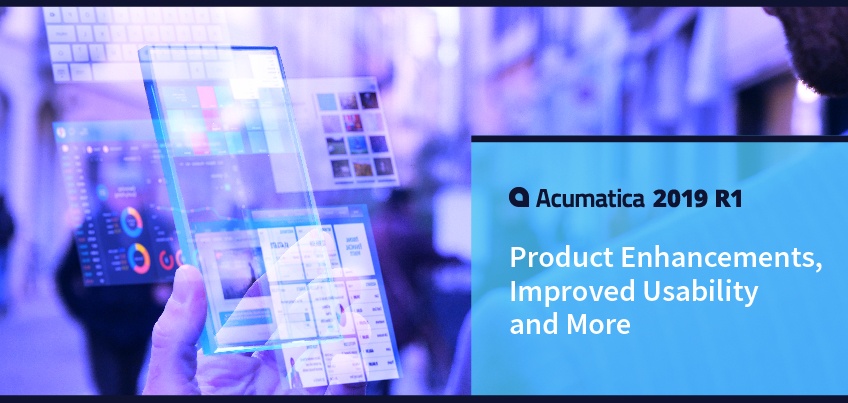Our latest release, Acumatica 2019 R1, provides comprehensive product enhancements. Users will experience improvements to our financial management software, inventory management software, project accounting, and field service management software.
Every application module of Acumatica’s cloud ERP solution has been enhanced in some way in Acumatica 2019 R1. Today, we’ll provide examples of the improvements in this new release, which were also presented at Acumatica Summit 2019 in Houston. For current customers and partners, the full set of Release Notes are available on the Acumatica Portal and a full recap of the Summit is posted.
Improving application functionality and cross-connected workflows
During Day Two of Acumatica Summit 2019, Acumatica CEO Jon Roskill said, “We love technology, but it’s not technology for technology’s sake. It’s technology and how we can apply it to very pragmatic problems in the real world.” This is apparent when you look at the improved functionality and cross-connected workflows that Acumatica 2019 R1 brings to the table.
Below are some of these specific improvements broken down by module:
Financial management
- Predefined list of currencies: Acumatica cloud ERP now provides a predefined list of all currencies included in the ISO 4217 standard. Financial management software users no longer need to manually enter the world currencies and their basic settings.
- Different Start Periods for Companies in the same tenant: Companies using Financial Management and having multiple legal entities within the same tenant can now have different fiscal year-end dates. With this functionality, an organization can accelerate implementation; simplify maintenance for companies that share vendors, stock items, and employees; run consolidated operational reports at any time; and facilitate the preparation of consolidated financial statements.
Order management and Inventory
- Automated Warehouse Operations (WMS): Clients with medium or large warehouses typically use external inventory management software or WMS (warehouse management system) solutions for supporting standard warehouse operations with inventory items, such as picking, packaging, PO receiving, putting away, transferring, and physical counting by using barcode scanners (or mobile devices with a scanning option).
- Ship-to info: Multiple shipments or orders with different addresses are included in the Sales Order invoice.
Project Accounting
- Multi-currency project accounting: Users can enter project transactions in different currencies and maintain projects in both the base currency and the project currency. With multi-currency project accounting, project managers and accountants can review actual revenues, actual costs, and committed costs in the project currency, with an ability to calculate project profitability in both the project currency and the base currency, and present costs to the customer in the customer’s currency.
- Project budget forecast by period: Enter and modify project budget forecasts and compare these forecasts with the actual project costs and incomes for each financial period. Users can forecast original and revised budget amounts and quantities for existing project budget lines for financial periods of the master calendar. Each project can have multiple budget forecast revisions. In a forecast revision, a user can distribute amounts and quantities of the project budget among the selected range of financial periods to speed data entry. By using forecast data, users can create generic inquiries and pivot tables.
- Company-Specific Financial Periods in Project Accounting: Companies using project accounting within the same tenant can have different fiscal year-end dates with this functionality. This is important for companies that share vendors, stock items, and employees. The company-specific periods are defined at the branch level.
Field Services
- Calendar boards: With field service management software, customize the calendar board by rotating the members vs time axis. Users can change the time range to show schedules for one week or one month. The user now can also reassign an appointment from one staff member to another on a different date, viewing the agenda for a group of staff members on a particular week or month, or viewing the availability of rooms on a particular week or month.
- Location Tracking: Using mobile device of the service personnel, the GPS location of any location can be tracked.
- Generate Invoice: From the Field Service application, the service personnel can now directly generate an invoice from a service order or an appointment.
Consistently improving platform usability
Our applications continue to grow in functionality, are designed to transparently work together across module boundaries, and are easy to use because of our xRP platform. In every release, we improve the underlying system to improve our customers’ experience.
Following are the enhancements Acumatica 2019 R1 brought to Acumatica’s cloud ERP platform.
- Custom color for User Interface: Ability to personalize the primary color of the company’s user interface. In addition, for multi-company or multi-branches, a different color can be specified for branch to make it easier for employees to distinguish these branches.
- Highlighting results in Inquiries: An option to highlight rows or columns of a generic inquiry based on conditions has been introduced. Base on the condition or formula, the system will highlight certain elements of a generic inquiry. For example, when inquiring on “opportunities”, the resulting grid can show those opportunities that have been won in green, those that have no owner can be yellow, and opportunities that are late can be red.
- Generic Inquiry Side Panel: The user can view the details of a row on the inquiry screen in the side panel. For sales orders, for instance, this could be the customer’s company information. Changes to the data can be made in the side panel and the information displayed can be data or dashboard graphics. In addition, fhe following improvements have been made to the side panel of generic inquiries: ability to resize the side panel and the new size saved automatically, a button has been added to maximize or minimize this panel, and side panel elements have been optimized to use window space more effectively.
- Improved help search via ML: In this release, Acumatica is using Machine Learning (ML) in the HELP text. Based on how effective the response to a natural language search has been, the system knows if it is serving up the correct results and adjusts.
- Link existing files to Acumatica entities: The ability to easily add links to the attachments that already exist in the system has been introduced. The user can add a link to the stored files right from the form to which the file should be attached. If the file is linked to multiple documents and a user wants to delete this file from one of them, after deletion, the file will be still available in the other documents. That is, the user deletes the link to the attachment, rather than deletes the file itself.
- User Defined Fields: Acumatica’s user-defined fields can be used in a customization project. The business user can customize forms by adding new fields in multiple forms in each of the modules without a programmer. If the field to be added has not already been defined, the user can define a new field by managing attributes on the pop-up attributes form.
- Progress Bar for long-running processing: The new Processing pop-up window provides visibility into the completion percentage, as well as the elapsed and remaining running time of the process. The window has tabs which record statuses: Processed, Errors, Warnings, and Remaining. Because it can run in the background, the user can do other work in the same browser tab, and the long-running process continues with the progress bar running in the background. Long-running processes can be graphically viewed on the System Monitor form.
- Multifactor authentication: Two-factor authentication has been introduced, whereby a user is granted access only after the user successfully presents to the system additional evidence of authentication in addition to the user credentials (that is, the username and password). At the system level, a system administrator can require two-factor authentication or turn off this authentication (the default setting). In addition, the administrator can specify different settings for individual users with regard to two-factor authentication; user settings take precedence over system-wide settings.
- New end-user training: New on-line training is being shipped with Acumatica 2019 R1. It will be available for anyone that wants to learn about the Acumatica software solution from reporting to system administration. This is available at no charge on Acumatica Open University.
Acumatica 2019 R1 supplies multiple pragmatic improvements
With the number of improvements brought by our latest release, the Acumatica community will continue to experience the highest cloud ERP standards and innovation industry-wide.
As Jon said in our Acumatica Summit and Acumatica 2019 R1 press release, “We’ve continued to listen to feedback from our customers and partners since the release of 2018 R2 last fall, resulting in continuous refinement and improvement of Acumatica’s cloud ERP offerings. This product release of 2019 R1 continues our independently-recognized industry leadership in usability and customer satisfaction across multiple business sectors.”
Our team is standing by to answer any questions you may have about Acumatica 2019 R1 or to take your feedback. If you’re interested in watching the Day One and Two Keynotes from Acumatica Summit 2019, they are available to download right now.


